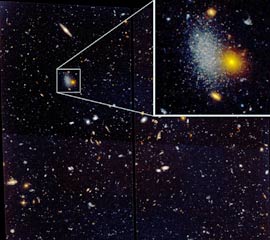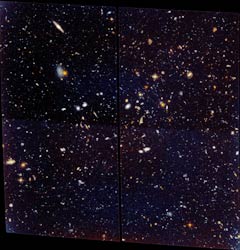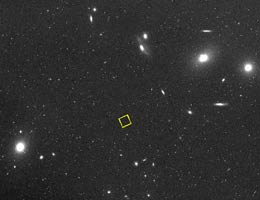
Astronomers found the boxed dwarf galaxy in the Virgo IntraCluster Stars (VICS) deep field. The image was taken by Hubble's Advanced Camera for Surveys over the course of 37 orbits. The box is about 3,000 light-years across. The small red objects are background galaxies. You can click on all of the images in this article to view larger versions.
Courtesy Ben Williams and Robin Ciardullo (Penn State Univ.) / Patrick Durrell (Youngstown State Univ.).
Astronomers have known for years that isolated stars and planetary nebulae roam the vast expanses of "empty" space within galaxy clusters. But what else populates these lonely depths, and why were these objects marooned from their parent galaxies?
To find out, an international team of 13 astronomers used the Hubble Space Telescope's Advanced Camera for Surveys (ACS) to stare for 25 hours at a relatively barren patch of space near the center of the Virgo Cluster. This vast assemblage contains more than 1,000 known galaxies and is centered about 55 million light-years from Earth, making it the largest galaxy cluster in the local universe. The ACS image covered an area of sky about 1 percent the size of the full Moon. Known as the Virgo IntraCluster Stars (VICS) project, it is one of the deepest Hubble images ever taken.

The Virgo Deep Field (VICS) shows a relatively 'empty' region of the Virgo Cluster. Most of the objects in the image are galaxies much farther than Virgo's 55-million-light-year distance. But some of the objects are stars, star clusters, and small galaxies within the cluster. The field is 3.36 by 3.36 arcminutes, about the angular size of a grain of sand held at arm's length.
Courtesy B. Williams / R. Ciardullo / P. Durrell.
In its preliminary analysis, announced earlier this month at the American Astronomical Society meeting in Washington, D.C., the team discovered thousands of intracluster stars, four globular clusters, and a dwarf galaxy. And as team leader Robin Ciardullo (Penn State University) points out, "We've really only started."
The stars and globulars were probably ripped out of their home galaxies by tidal interactions when two or more galaxies passed close to one another. Future studies of the VICS field will yield insights into the stripping process and the history of the Virgo Cluster.
Besides tidal stripping, supermassive black holes can also cast stars adrift in a slingshot manner. In recent computer simulations, Kelly Holley-Bockelmann (Penn State University), Ciardullo, and four colleagues find that three fast-moving intracluster planetary nebulae in Virgo could have been ejected when their parent stars passed near a binary supermassive black hole in the center of M87. This giant elliptical galaxy, which lies at the cluster's core, is known to host a central black hole with roughly 3 billion solar masses. But even that monster probably can't do the job by itself. The simulations strongly suggest that a second supermassive black hole is needed to boost the progenitor stars to the observed velocities of the three planetary nebulae (these objects are the death shrouds of normal stars).

This ground-based telescope image from the Digitized Sky Survey shows the core of the Virgo Cluster. The VICS field is boxed. Three large elliptical galaxies dominate the field: M87 (lower left), and M86 and M84 (the two brightest galaxies in the upper right).
Courtesy Digitized Sky Survey / STScI / Caltech / NSF / NASA / National Geographic Society / Sloan Foundation / Samuel Oschin Foundation / Eastman Kodak Corp.
"While we have good reason to suspect that binary black holes may be at the center of large galaxies, we have no proof that M87 hosts a binary black hole," says Holley-Bockelmann. But she points out that studies of ejected "debris" in various clusters could, in principle, yield evidence for binary supermassive black holes.
"Some fraction of galaxies must have these things, and thus some fraction of the intracluster stars must be ejected by this mechanism," adds Ciardullo. "The trick, which requires a lot more observations, is to identify which objects have been ejected in what way, and which galaxies have the binary black holes."
 0
0
Comments
You must be logged in to post a comment.